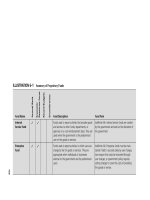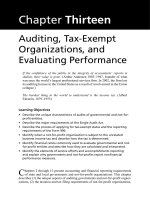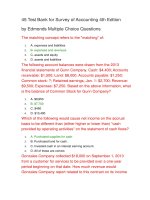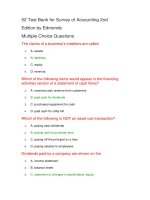Test bank for survey of accounting 2nd edition
Bạn đang xem bản rút gọn của tài liệu. Xem và tải ngay bản đầy đủ của tài liệu tại đây (77.08 KB, 16 trang )
Test Bank for Survey of Accounting 2nd Edition
Multiple Choice Questions
Rowena Company spent cash to purchase equipment. As a
result of this event,
1.
A. total liabilities increased.
2.
B. total assets increased.
3.
C. net income increased.
4.
D. total assets were unchanged.
The accounting equation may be written,
1.
A. Revenues - Expenses = Net Income
2.
B. Assets = Liabilities
3.
C. Liabilities = Equity
4.
D. Assets = Claims
The amount of land owned by a business appears on which
financial statement?
1.
A. income statement
2.
B. statement of changes in stockholders' equity
3.
C. statement of cash flows
4.
D. balance sheet
An asset decrease resulting from consumption of resources to
earn revenue is
1.
A. a net loss.
2.
B. a liability.
3.
C. an expense.
4.
D. an asset source transaction.
Dividends paid by a company are shown on the
1.
A. income statement.
2.
B. balance sheet.
3.
C. statement of changes in stockholders' equity.
4.
D. all of these.
The claims of a business's creditors are called
1.
A. assets.
2.
B. liabilities.
3.
C. equity.
4.
D. revenue.
A creditor
1.
A. provides financial resources to a business in exchange for an ownership interest.
2.
B. provides labor resources to a business.
3.
C. lends financial resources to a business.
4.
D. is a resource user.
An asset use transaction
1.
A. increases one asset and decreases another.
2.
B. decreases an asset and decreases a liability or equity.
3.
C. increases an asset and decreases a liability or equity.
4.
D. increases an asset and increases a liability or equity.
Which of the following items would appear on a balance sheet?
1.
A. Notes Payable
2.
B. Dividends
3.
C. Expenses
4.
D. Revenues
Most assets must be reported on the balance sheet at
1.
A. their current replacement cost.
2.
B. fair market value.
3.
C. an amount estimated by the company's management.
4.
D. historical cost.
Which of the following transactions is an asset source
transaction?
1.
A. acquired office supplies by signing a short-term note payable
2.
B. paid cash to purchase land
3.
C. paid cash for operating expenses
4.
D. paid cash dividends to owners
Accounting information is said to be reliable if
1.
A. it is based on recent information.
2.
B. it was prepared by someone with good credentials in accounting, such as a certified
public accountant.
3.
C. it can be independently verified.
4.
D. it complies with rules and standards of the Internal Revenue Service.
Liabilities are shown on the
1.
A. income statement.
2.
B. statement of changes in stockholders' equity.
3.
C. statement of cash flows.
4.
D. balance sheet.
In event of liquidation of a business,
1.
A. creditors have priority claim on the business's assets.
2.
B. investors have priority claim on the business's assets.
3.
C. resource users have priority claim on the business's assets.
4.
D. stakeholders are assured of receiving the resources they had provided to the
business.
In 1998, Parker Corporation purchased land for $130,000. In
2010, Parker Company had the land appraised, and its
value was estimated to be $190,000. Also during 2010,
another company offered Parker $145,000 for the parcel of
land. When the balance sheet is prepared at the end of
2010, at what dollar amount should the land be reported?
1.
A. $190,000
2.
B. $145,000
3.
C. $130,000
4.
D. None of these
The term "articulation"
1.
A. requires that asset decreases (expenses) be matched with asset increases
(revenues).
2.
B. refers to the requirement that separate financial statements be prepared for
separate entities.
3.
C. means that a business's financial statements are prepared for specified periods of
time.
4.
D. indicates that there are interrelationships among a business's financial statements.
Assuming that Hardin engaged in no transactions during the
year other than those listed above, what was the amount
of net income or loss for the year?
1.
A. $19,000 net income
2.
B. $15,000 net income
3.
C. $12,000 net income
4.
D. $11,000 net loss
Which of the following items would be an example of revenue?
1.
A. cash investments made by owners
2.
B. cash received from a bank loan
3.
C. cash received from customers for services provided
4.
D. all of these
An asset source transaction
1.
A. increases one asset and decreases another.
2.
B. increases an asset and increases a liability or equity.
3.
C. increases an asset and decreases a liability or equity.
4.
D. decreases an asset and increases a liability.
As of December 31, 2009, Bueno Company had $1,000 in
liabilities, $8,000 in common stock, and $2,500 in retained
earnings. The total amount of assets on that date is
1.
A. $10,000.
2.
B. $12,500.
3.
C. $11,500.
4.
D. $7,500.
Generally accepted accounting principles (GAAP) are
measurement rules for
1.
A. managerial accounting.
2.
B. financial accounting
3.
C. tax accounting.
4.
D. determining the market rate of return on a company's stock.
The balance sheet for Raymond Company shows total assets of
$4,000, liabilities of $1,500, and retained earnings of
$1,200. Based on this information, the amount of common
stock must be
1.
A. $1,300.
2.
B. $5,500.
3.
C. $4,200.
4.
D. $1,700.
Which financial statement matches asset increases from
operating a business with asset decreases from operating
the business?
1.
A. statement of changes in equity
2.
B. balance sheet
3.
C. income statement
4.
D. statement of cash flows
A company's retained earnings at the beginning and ending of
the accounting period were $48,000 and $55,000,
respectively. If the company had revenues of $61,000 and
expenses of $50,000, the amount of cash dividends paid
must have been
1.
A. $2,000.
2.
B. $9,000.
3.
C. $3,000.
4.
D. $4,000.
The claims side of the accounting equation
1.
A. lists the resources that a business owns or controls.
2.
B. lists the sources of the business's assets.
3.
C. must balance out to zero.
4.
D. indicates the amount of profit that a business has earned.
Pardee Company earned $25,000 of cash revenue. What kind of
transaction is this?
1.
A. asset use transaction
2.
B. asset exchange transaction
3.
C. asset source transaction
4.
D. claims source transaction
Which of the following is NOT an asset use transaction?
1.
A. paying cash dividends
2.
B. paying cash to purchase land
3.
C. paying off the principal on a loan
4.
D. paying salaries to employees
Retained Earnings is
1.
A. a part of a company's assets.
2.
B. a category or type of liability.
3.
C. a part of stockholders' equity.
4.
D. a result of asset use transactions.
Accounting information focused on the needs of external users
is
1.
A. financial accounting.
2.
B. managerial accounting.
3.
C. claims accounting.
4.
D. not-for-profit accounting.
Expenses are shown on the
1.
A. income statement.
2.
B. statement of changes in stockholders' equity.
3.
C. balance sheet.
4.
D. all of these.
Bridges Company earned $4,000 in cash revenues, paid cash
expenses of $3,450, and paid a cash dividend of $300 to
its owners. It engaged in no other transactions during the
period. Which of the following statements is true?
1.
A. The cash flow from financing activities was $0.
2.
B. The net cash flow from operating activities was an inflow or increase of $550.
3.
C. The net cash flow from operating activities was an inflow or increase of $250.
4.
D. The cash flow from investing activities was an increase of $250.
What amount of cash did Hardin have at the end of 2010?
1.
A. $48,000
2.
B. $56,000
3.
C. $52,000
4.
D. $67,000
Which financial statement reports the results of a business's
operations?
1.
A. income statement
2.
B. statement of changes in equity
3.
C. balance sheet
4.
D. statement of cash flows
What was the cash flow from financing activities?
1.
A. an inflow of $60,000
2.
B. an inflow of $52,000
3.
C. an inflow of $36,000
4.
D. an inflow of $48,000
During 2010, Cruz Company earned $5,000 in cash revenue,
incurred $3,200 in cash expenses, and paid $500 in cash
dividends to its owners. Based on this information,
1.
A. retained earnings increased by $1,300 during the year.
2.
B. net income was $1,300 for 2010.
3.
C. the net cash flow from operating activities was $1,300 for the year.
4.
D. total assets increased by $1,800 during 2010.
Which of the following groups has primary responsibility for
establishing generally accepted accounting principles for
businesses in the United States?
1.
A. the US Congress
2.
B. the Securities and Exchange Commission
3.
C. the Financial Accounting Standards Board
4.
D. the Internal Revenue Service
An investor provides resources to a business in exchange for
1.
A. physical resources.
2.
B. priority of claims in event of liquidation.
3.
C. an ownership interest in the business.
4.
D. a promise that the resources will be repaid at a given date.
Which of the following transactions is an asset use
transaction?
1.
A. payment of cash dividends to owners
2.
B. paying cash to acquire furniture
3.
C. acquiring cash by issuing stock to owners
4.
D. providing services to customers for cash
Wayne Company purchased equipment for $45,000 cash. As a
result of this event, Wayne had a
1.
A. $45,000 cash outflow from financing activities.
2.
B. $45,000 cash inflow from financing activities.
3.
C. $45,000 cash outflow from investing activities.
4.
D. $45,000 cash outflow from operating activities.
Hanks Corporation acquired $150,000 cash by issuing common
stock to investors. As a result of this event,
1.
A. retained earnings increased.
2.
B. assets increased.
3.
C. liabilities increased.
4.
D. both B and C.
Liabilities are
1.
A. claims of creditors.
2.
B. the owner's interest in the company.
3.
C. claims of investors.
4.
D. both A and B.
Which of the following items would appear in the financing
activities section of a statement of cash flows?
1.
A. received cash revenue from customers
2.
B. paid cash for dividends
3.
C. purchased equipment for cash
4.
D. paid cash for utility bill
Ohio Company provided services to a customer for $1,700 cash.
As a result of this event,
1.
A. total assets decreased.
2.
B. total liabilities increased.
3.
C. retained earnings increased.
4.
D. cash flows from financing activities increased.
Chen Company paid $3,000 cash for utility expenses. What kind
of transaction is this?
1.
A. asset source transaction
2.
B. asset use transaction
3.
C. asset exchange transaction
4.
D. claims source transaction
What was the cash flow from investing activities?
1.
A. an outflow of $15,000
2.
B. an outflow of $19,000
3.
C. an inflow of $65,000
4.
D. an outflow of $23,000
A business's equity comes from
1.
A. its creditors.
2.
B. investments by owners.
3.
C. amounts earned by the business.
4.
D. both B and C
Resources that a business uses to operate the business are
called
1.
A. assets.
2.
B. equity.
3.
C. revenues.
4.
D. liabilities.
The broad categories of information reported on a business's
financial statements are referred to as
1.
A. accounts.
2.
B. elements of the financial statements.
3.
C. components.
4.
D. assets.
A stockholder in a corporation would use ___ to learn about the
company.
1.
A. financial accounting information
2.
B. managerial accounting information
3.
C. not-for-profit accounting information
4.
D. both A and C
If a company receives cash for providing services to customers,
that transaction is
1.
A. an asset source transaction.
2.
B. an asset use transaction.
3.
C. an asset exchange transaction.
4.
D. either A or C
Hardin Company began operations in 2010. During the year, the
following cash transactions occurred: issued stock for
$40,000; borrowed $24,000 from bank; provided services
to customers for $53,000 cash; paid back $8,000 of the
loan from the bank5. paid rent expense, $9,000;
purchased equipment costing $19,000; paid operating
expenses, $29,000; paid $4,000 dividend to stockholders.
What was the cash flow from operating activities?
1.
A. an inflow of $4,000
2.
B. an inflow of $19,000
3.
C. an inflow of $11,000
4.
D. an inflow of $15,000
If a company's expenses are greater than its revenues for the
year,
1.
A. its assets increased during the period.
2.
B. the company incurred a net loss during the period.
3.
C. the company's liabilities must have increased.
4.
D. the company's stockholders' equity must have decreased during the period.
True - False Questions
The historical cost concept requires that most assets be
reported at the amount paid for them.
1.
True
2.
False
The sources of a business's assets are liabilities and
distributions to owners.
1.
True
2.
False
Issuance of common stock is an asset use transaction.
1.
True
2.
False
The accounting equation may be written, "Assets = Claims" or
"Assets = Liabilities + Equity."
1.
True
2.
False
A business and a person who owns the business are separate
reporting entities.
1.
True
2.
False
A business can obtain resources through its earnings activities.
1.
True
2.
False
The balance sheet reports a business's assets and the claims to
those assets.
1.
True
2.
False
The income statement matches expenses and revenues.
1.
True
2.
False
A business's equity is the future obligations of the entity.
1.
True
2.
False
Dividends that a company pays to its stockholders are treated
as an expense of the business.
1.
True
2.
False
The accounting term "reliability" means that information is
consistent from one accounting period to the next.
1.
True
2.
False
The four financial statements prepared by a business are not
interrelated.
1.
True
2.
False
The account, "Land," is a subclassification of the "Liabilities"
element of the financial statements.
1.
True
2.
False
Both liabilities and equity are sources of a business's assets.
1.
True
2.
False
An asset exchange transaction does not affect the total amount
of liabilities and equity of a business.
1.
True
2.
False
Net income is an increase in assets as a result of operating a
business.
1.
True
2.
False
Accounting is an information system that reports on the
activities of an organization.
1.
True
2.
False
The Financial Accounting Standards Board is the primary
authority for establishing accounting standards for
businesses in the United States.
1.
True
2.
False
The difference between asset increases and asset decreases
from operating a business is called income or earnings.
1.
True
2.
False
An asset exchange transaction does not affect the total amount
of assets of an entity.
1.
True
2.
False
Investors in a business expect to receive a share of the income
earned by the business.
1.
True
2.
False
Accounts are subclassifications of the various elements of the
financial statements.
1.
True
2.
False
An asset source transaction increases a business's assets and
the claims to assets.
1.
True
2.
False
Investors and creditors use accounting information to identify
the businesses they wish to provide resources to.
1.
True
2.
False
A business's creditors have a priority claim to its assets in the
event of liquidation.
1.
True
2.
False









